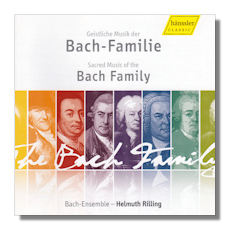
The Internet's Premier Classical Music Source
Related Links
- Bach Family Reviews
- Latest Reviews
- More Reviews
-
By Composer
-
Collections
DVD & Blu-ray
Books
Concert Reviews
Articles/Interviews
Software
Audio
Search Amazon
Recommended Links
Site News
 CD Review
CD Review
Sacred Music Of The Bach Family

- Johann Bach:
- Unser Leben ist ein Schatten: #5, Ach wie flüchtig, ach wie nichtig
- Johann Ludwig Bach:
- Die mit Tränen säen
- Johann Sebastian Bach:
- Ich lasse dich nicht, BWV Anh. 159: Es ist vollbracht
- Georg Christoph Bach:
- Siehe, wie fein und lieblich "Geburtstagkantate"
- Johann Nicolaus Bach:
- Missa Brevis "Allein Gott in der Höh sei Ehr"
- Wilhelm Friedrich Ernst Bach:
- Vater unser
- Wilhelm Friedemann Bach:
- Erzittert und fallet, F 83: #2, Was für reizend sanfte Blicke
- Johann Christian Bach:
- Messa de' morti: Introitus/Kyrie/Dies irae
- Heinrich Bach:
- Ach, dass ich Wassers gnug hätte
- Johann Christoph Bach:
- Wie bist du denn, o Gott
- Johann Michael Bach:
- Sei, lieber Tag, willkommen
- Johann Ernst Bach:
- Die Liebe Gottes ies ausgegossen
- Johann Christoph Friedrich Bach:
- Motets (2), HW 15: Wachet auf, ruft uns die Stimme
Bach-Ensemble
Gächinger Kantorei Stuttgart/Helmuth Rilling
Hänssler Classic 98614 3CDs
"Historically-informed" music on period instruments this is not; nor one-to-a-part. Certainly not a luxurious "study" volume… there is a simple booklet with basic singers' or performers' details and a basic introduction; no texts. But it's a three-CD set of real value on two counts and, especially for a price of barely $10 a CD, worth looking at seriously.
In the first place, the concept of assembling almost a dozen and a half works by members of the Bach family side by side goes a long way towards enhancing our understanding and appreciation of the depth, breadth and variety, not to say the influence, of the Bach dynasty in the central and east regions of Germany from the early seventeenth to the mid nineteenth centuries. It would be going too far to claim that Johann Sebastian Bach can only be understood in the context of his predecessors and sons, grandsons etc. Yet our comprehension of the immensity of his talent, originality, his reach, the changes he made to Baroque music stands to increase significantly if we have greater knowledge of Sebastian Bach's humility, devotion to his faith and extremely rounded musicality. Awareness of the paths in analogous directions taken by members of his family cannot but aid such a process.
At the same time, even a casual experience to this set reveals how significant, beautiful, varied and original were the many compositions of other Bachs… listen to the extended cantata, Erzittert und fallet, F 83: no 2, Was für reizend sanfte Blicke [CD.2. tr.1] by Sebastian's son, Wilhelm Friedemann Bach (1710-1784). It has passion, tunefulness, containment and an utterly satisfying combination of enlightened vocal stimulation with insistent and profound string colors. Moving backwards to the Wie bist du denn, o Gott [CD.3 tr.2] of the equally great Johann Christoph Bach (1642-1703), once senses something of the mix of confidence in melodic invention that allowed Sebastian to write as he did. By the same token, the Messa de' morti: Introitus/Kyrie/Dies irae of Johann Christian Bach (1735-1782) link to the sublimeness of the Classical period, and – surely – Mozart. These movements are played with typical Rilling dignity and brilliance. They approach the lush, to be sure. But Rilling elicits a transparency and conviction that is exemplary. Not least because nothing is overplayed; there are no histrionics or undue darkness. For many they will be the highlight of the set: they certainly give Mozart's choral music a run for its money; the Dies Irae, perhaps the most impressive of the set's later music, is the only recording available, and is the one best suited to Rilling's brushed silk style.
Similarly, the achingly beautiful Ach, dass ich Wassers gnug hätte by the rarely heard Heinrich Bach (1615-1692) reminds you at the start of the third CD of the same two themes: the extraordinary variety in the Bachs' imagination and the subtlety and sensitivity of their vision. Immediately following is the even more under-rated Johann Christoph Bach's (1642-1703) Wie bist du denn, o Gott. But each performance shows the other side of Rilling's conception of the music… its almost symphonic appeal, certainly his belief that euphony, smoothness and a holistic, rounded, complete approach is more important than pulling out every angle, exploring every offbeat bar and singling out solo instrumental contributions in their own right.
If by now you're open to the notion that this music by Bach's family has its own merits and rewards, then even the minor works like Sei, lieber Tag, willkommen by Johann Michael Bach (1648-1694) have their own very real appeal. As was suggested when reviewing Rilling's J.S. Bach cantata set (Hänssler Classic 98630, if there's a fault, it's a certain uniformity, in contrast to the greater attention to Baroque rhythms, ornamentation and idiom which period instruments would have brought. The sound is dated. But never either muffled or over-produced. What's more, the vocal impact of the bevy of unnamed singers is superb… they sing clearly, precisely and with impeccable projection without ever over-romanticizing their delivery.
If you're a devotee of J.S. Bach and perhaps know the odd piece by C.P.E. (who is absent from this set), who was, of course, held in greater esteem during his life than was his father, then don't hesitate to explore the gems on this Hänssler Classic set. Not for a collection of disconnected lollipops; but for a sensible and well-planned (there is variety in the non-chronological sequence in which the works appear on the three disks) selection which both enhances the stature of the family as a whole and reveals many works of stunning beauty and mature profundity. The acoustic (SPARS ADD) is neither over-generous nor unduly boxy.
Copyright © 2012, Mark Sealey.





















